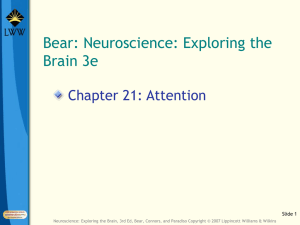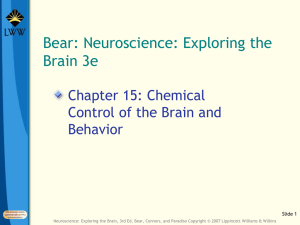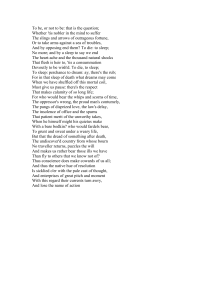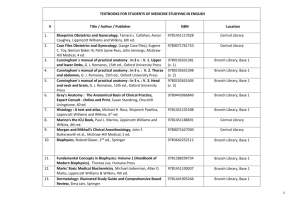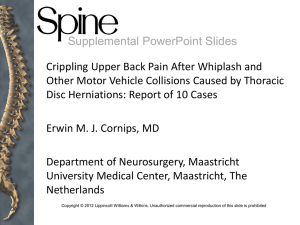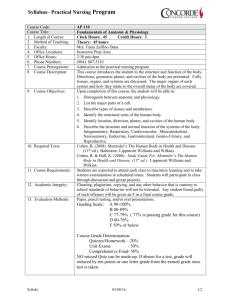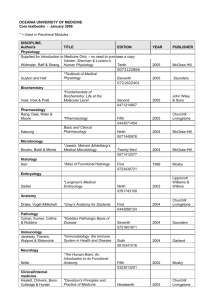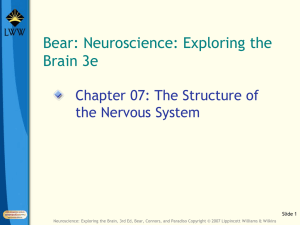Chapter 19: Brain Rhythms and Sleep
advertisement
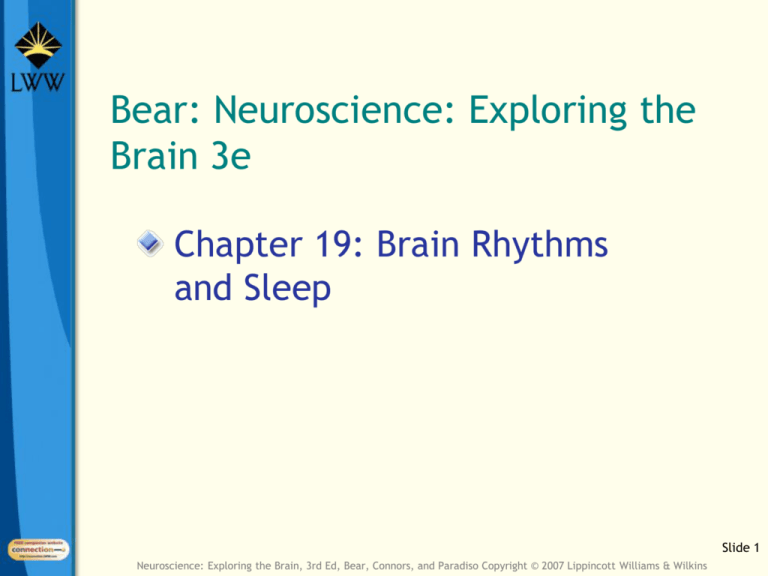
Bear: Neuroscience: Exploring the Brain 3e Chapter 19: Brain Rhythms and Sleep Slide 1 Neuroscience: Exploring the Brain, 3rd Ed, Bear, Connors, and Paradiso Copyright © 2007 Lippincott Williams & Wilkins Introduction Rhythmic Controls of Brain Sleeping and waking, hibernation, breathing, walking, electrical rhythms of cerebral cortex Cerebral cortex: Range of rapid electrical rhythms EEG: Classical method of recording brain rhythms Circadian rhythms: Change in physiological functions according to daily clocks in brain Slide 2 Neuroscience: Exploring the Brain, 3rd Ed, Bear, Connors, and Paradiso Copyright © 2007 Lippincott Williams & Wilkins The Electroencephalogram The Electroencephalogram (EEG) Measurement providing glimpse of generalized activity of cerebral cortex Function Diagnose neurological conditions such as epilepsy, research purpose Richard Caton in 1875, electrical recordings from surface of dog and rabbit brains using primitive device sensitive to voltage Hans Berger in 1929, human EEG Slide 3 Neuroscience: Exploring the Brain, 3rd Ed, Bear, Connors, and Paradiso Copyright © 2007 Lippincott Williams & Wilkins The Electroencephalogram Recording Brain Waves Electrodes to scalp, low-resistance connection Connected to banks of amplifiers and recording devices Voltage fluctuations measured (tens of microvolts) Electrode pairs: Measure different brain regions Set of simultaneous squiggles, voltage changes between electrode pairs Slide 4 Neuroscience: Exploring the Brain, 3rd Ed, Bear, Connors, and Paradiso Copyright © 2007 Lippincott Williams & Wilkins The Electroencephalogram EEG Fluctuations and Oscillations Slide 5 Neuroscience: Exploring the Brain, 3rd Ed, Bear, Connors, and Paradiso Copyright © 2007 Lippincott Williams & Wilkins The Electroencephalogram Magnetoencephalography (MEG) Recording miniscule magnetic signals generated by neural activity Comparison with EEG, fMRI, PET MEG localizes sources of neural activity better than EEG MEG cannot provide detailed images of fMRI EEG, MEG measure neuron activity, fMRI, PET changes in blood flow, metabolism Slide 6 Neuroscience: Exploring the Brain, 3rd Ed, Bear, Connors, and Paradiso Copyright © 2007 Lippincott Williams & Wilkins The Electroencephalogram EEG Rhythms Categorization of rhythms based on frequency Beta: Greater than 14 Hz, activated cortex Alpha: 8-13 Hz, quiet, waking state Theta: 4-7 Hz, some sleep states Delta: Less than 4 Hz, deep sleep Deep Sleep High synchrony, high EEG amplitude Slide 7 Neuroscience: Exploring the Brain, 3rd Ed, Bear, Connors, and Paradiso Copyright © 2007 Lippincott Williams & Wilkins The Electroencephalogram Mechanisms and Meanings of Brain Rhythms Synchronized oscillation mechanisms Central clock/Pacemaker Collective methods (“jam session”) Thalamus massive cortical input influence cortex Neuronal oscillations Voltage-gated ion channels Slide 8 Neuroscience: Exploring the Brain, 3rd Ed, Bear, Connors, and Paradiso Copyright © 2007 Lippincott Williams & Wilkins The Electroencephalogram Functions of Brain Rhythms Scarcity of data No satisfactory answers Hypotheses Brain’s way of disconnecting cortex from sensory input No direct function, by-products of strongly interconnected circuits Walter Freeman Neural rhythms coordinate activity, synchronize oscillations, bind together Slide 9 Neuroscience: Exploring the Brain, 3rd Ed, Bear, Connors, and Paradiso Copyright © 2007 Lippincott Williams & Wilkins The Electroencephalogram The Seizures of Epilepsy Epilepsy: Repeated seizures Causes: Tumor, trauma, infection, vascular disease, many cases unknown Generalized: Entire cerebral cortex, complete behavior disruption, consciousness loss Partial: Circumscribed cortex area, abnormal sensation or aura Absence: Less than 30 sec of generalized, 3 Hz EEG waves Slide 10 Neuroscience: Exploring the Brain, 3rd Ed, Bear, Connors, and Paradiso Copyright © 2007 Lippincott Williams & Wilkins Sleep Sleep Universal among higher vertebrates Sleep deprivation, devastating One-third of lives in sleep state Defined: “Sleep is a readily reversible state of reduced responsiveness to, and interaction with, the environment.” Slide 11 Neuroscience: Exploring the Brain, 3rd Ed, Bear, Connors, and Paradiso Copyright © 2007 Lippincott Williams & Wilkins Sleep The Functional States of the Brain Slide 12 Neuroscience: Exploring the Brain, 3rd Ed, Bear, Connors, and Paradiso Copyright © 2007 Lippincott Williams & Wilkins Sleep Physiological changes during non-REM and REM sleep Slide 13 Neuroscience: Exploring the Brain, 3rd Ed, Bear, Connors, and Paradiso Copyright © 2007 Lippincott Williams & Wilkins Sleep The Sleep Cycle Slide 14 Neuroscience: Exploring the Brain, 3rd Ed, Bear, Connors, and Paradiso Copyright © 2007 Lippincott Williams & Wilkins Sleep Why Do We Sleep? Sleep Mammals, birds, reptiles Recovery time for brain Theories of restoration Restoration: Sleep to rest and recover, and prepare to be awake again Theories of adaptation Adaptation: Sleep to keep out of trouble, hide from predators Slide 15 Neuroscience: Exploring the Brain, 3rd Ed, Bear, Connors, and Paradiso Copyright © 2007 Lippincott Williams & Wilkins Sleep Functions of Dreaming and REM Sleep Body requires REM sleep Sigmund Freud: Dream functions- Wishfulfillment, conquer anxieties Allan Hobson and Robert McCarley: Activation-synthesis hypothesis Avi Karni: Certain memories require strengthening period REM sleep Slide 16 Neuroscience: Exploring the Brain, 3rd Ed, Bear, Connors, and Paradiso Copyright © 2007 Lippincott Williams & Wilkins Sleep Neural Mechanisms of Sleep Basic Principles Critical neurons Diffuse modulatory neurotransmitter systems Noradrenergic and serotoninergic neurons: Fire during and enhance waking state Cholinergic neurons: enhance REM events; active during waking Diffuse modulatory system control rhythmic behaviors of thalamus controls cortical EEG sensory input flow to cortex blocked by slowed thalamic rhythms Activity in descending branches of diffuse modulatory systems (e.g., inhibitory neurons) Slide 17 Neuroscience: Exploring the Brain, 3rd Ed, Bear, Connors, and Paradiso Copyright © 2007 Lippincott Williams & Wilkins Sleep Wakefulness and the Ascending Reticular Activating System Giuseppe Moruzzi: Lesions in midline structure of brain: State similar to non-REM sleep Lesions in lateral tegmentum: Does not cause non-REM state sleep Electrical stimulation of midline tegmentum of midbrain: Cortex moved from slow, rhythmic EEGs of non-REM sleep to alert and aroused state Slide 18 Neuroscience: Exploring the Brain, 3rd Ed, Bear, Connors, and Paradiso Copyright © 2007 Lippincott Williams & Wilkins Sleep Falling Asleep and Non-REM State Sleep: Progression of changes ending in non-REM state Non-REM sleep: Decrease in firing rates of most brain stem modulatory neurons using NE, 5-HT, ACh Stages of non-REM sleep: EEG sleep spindles Spindles disappear Replaced by slow, delta rhythms (less than 4 Hz) Slide 19 Neuroscience: Exploring the Brain, 3rd Ed, Bear, Connors, and Paradiso Copyright © 2007 Lippincott Williams & Wilkins Sleep Mechanisms of REM Sleep Control of REM sleep Diffuse modulatory systems Pons Decreased firing of neurons in locus coeruleus and raphe nuclei Concurrent sharp increase in ACh neuron activity REM sleep behavior disorder: Act out dreams Slide 20 Neuroscience: Exploring the Brain, 3rd Ed, Bear, Connors, and Paradiso Copyright © 2007 Lippincott Williams & Wilkins Sleep Sleep-Promoting Factors Muramyl dipeptide: isolated from the CSF of sleep-deprived goats, facilitates non-REM sleep Interleukin-1: Synthesized in brain (glia, macrophages), stimulates immune system Adenosine: Sleep promoting factor; released by neurons; may have inhibitory effects of diffuse modulatory systems Melatonin: Produced by pineal gland, released at night-inhibited during the day (circadian regulation); initiates and maintain sleep; treat symptoms of jet lag and insomnia Slide 21 Neuroscience: Exploring the Brain, 3rd Ed, Bear, Connors, and Paradiso Copyright © 2007 Lippincott Williams & Wilkins Sleep Gene Expression During Sleeping and Waking Cirelli and Tononi: Comparison of gene expression in brains of awake and sleeping rats 0.5% of genes showed differences of expression levels in two states Increased in awake rats Intermediate early genes Mitochondrial genes Increased in sleeping rats: protein synthesis- and plasticity-related genes Changes specific to brain not other tissues Slide 22 Neuroscience: Exploring the Brain, 3rd Ed, Bear, Connors, and Paradiso Copyright © 2007 Lippincott Williams & Wilkins Circadian Rhythms Circadian rhythms circa = approximately; dies = a day Daily cycles of light and dark Schedules of circadian rhythms vary among species Physiological and biochemical processes in body: Rise and fall with daily rhythms Daylight and darkness cycles removed, circadian rhythms continue Brain clocks Slide 23 Neuroscience: Exploring the Brain, 3rd Ed, Bear, Connors, and Paradiso Copyright © 2007 Lippincott Williams & Wilkins Circadian Rhythms Biological Clocks Jacques d'Ortous de Mairan Mimosa plant Leaf movement continues on ‘schedule’ in the dark sensing sun movement Augustin de Candolle Plant responded to internal biological clock Zeitgebers (German for “time-givers”) Environmental time cues For mammals: Primarily light-dark cycle Slide 24 Neuroscience: Exploring the Brain, 3rd Ed, Bear, Connors, and Paradiso Copyright © 2007 Lippincott Williams & Wilkins Circadian Rhythms Biological Clocks (cont’d) Free-run: Mammals completely deprived of zeitgebers, settle into rhythm of activity and rest, period a little more or less than 24 hours Components of biological clock Light-sensitive input pathway Clock Output pathway Slide 25 Neuroscience: Exploring the Brain, 3rd Ed, Bear, Connors, and Paradiso Copyright © 2007 Lippincott Williams & Wilkins Circadian Rhythms The Suprachiasmatic Nucleus: A Brain Clock Small nucleus in the hypothalamus Serves as biological clock Slide 26 Neuroscience: Exploring the Brain, 3rd Ed, Bear, Connors, and Paradiso Copyright © 2007 Lippincott Williams & Wilkins Circadian Rhythms A New Type of Photoreceptor Berson and colleagues: Discovered specialized type of ganglion cell in retina Photoreceptor, but not rod or cone cell Contains melanopsin, slowly excited by light Synapses directly onto SCN neurons SCN output axons: Parts of the hypothalamus, midbrain, diencephalons, use GABA as primary neurotransmitter, lesions disrupt circadian rhythms Slide 27 Neuroscience: Exploring the Brain, 3rd Ed, Bear, Connors, and Paradiso Copyright © 2007 Lippincott Williams & Wilkins Circadian Rhythms SCN Mechanisms Intact SCN produces rhythmic message: Efferent axons use action potentials, SCN cell firing rate varies with circadian rhythm Each SCN cell is a small clock TTX does not disrupt their rhythmicity Suggests that action potentials don’t play a role Slide 28 Neuroscience: Exploring the Brain, 3rd Ed, Bear, Connors, and Paradiso Copyright © 2007 Lippincott Williams & Wilkins Circadian Rhythms SCN Mechanisms (Cont’d) Molecular Clocks Similar basis in humans, mice, flies, mold Clock genes Period (Per) Timeless (Tim) Clock Takahashi: Regulation of transcription and translation, negative feedback loop Slide 29 Neuroscience: Exploring the Brain, 3rd Ed, Bear, Connors, and Paradiso Copyright © 2007 Lippincott Williams & Wilkins Circadian Rhythms SCN Mechanisms Molecular Clocks (Cont’d) Slide 30 Neuroscience: Exploring the Brain, 3rd Ed, Bear, Connors, and Paradiso Copyright © 2007 Lippincott Williams & Wilkins Concluding Remarks Rhythms Ubiquitous in the mammalian CNS Intrinsic brain mechanisms Environmental factors Interaction of neural processes and zeitgebers (like SCN clock) Function of rhythms Unknown but arise mainly as a secondary consequence Sleep research Little known about why we sleep to the function of dreams and sleep Slide 31 Neuroscience: Exploring the Brain, 3rd Ed, Bear, Connors, and Paradiso Copyright © 2007 Lippincott Williams & Wilkins End of Presentation Slide 32 Neuroscience: Exploring the Brain, 3rd Ed, Bear, Connors, and Paradiso Copyright © 2007 Lippincott Williams & Wilkins
